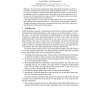Free Online Productivity Tools
i2Speak
i2Symbol
i2OCR
iTex2Img
iWeb2Print
iWeb2Shot
i2Type
iPdf2Split
iPdf2Merge
i2Bopomofo
i2Arabic
i2Style
i2Image
i2PDF
iLatex2Rtf
Sci2ools
89
Voted
CC
2003
Springer
2003
Springer
The Interprocedural Express-Lane Transformation
Abstract. The express-lane transformation isolates and duplicates frequently executed program paths, aiming for better data-flow facts along the duplicated paths. An express-lane ¤ is a copy of a frequently executed program path such that ¤ has only one entry point at its beginning; ¤ may have branches back to the original code, but the original code never branches into ¤ . Classical data-flow analysis is likely to find sharper data-flow facts along an express-lane, because there are no join points. This paper describes several variants of interprocedural express-lane transformations; these duplicate hot interprocedural paths, i.e., paths that may cross procedure boundaries. The paper also reports results from an experimental study of the effects of the express-lane transformation on interprocedural range analysis.
CC 2003 | Express-lane Transformation | Express-lane Transformation Isolates | Program Path | Programming Languages |
Related Content
| Added | 06 Jul 2010 |
| Updated | 06 Jul 2010 |
| Type | Conference |
| Year | 2003 |
| Where | CC |
| Authors | David Melski, Thomas W. Reps |
Comments (0)

